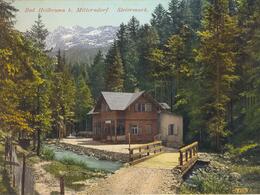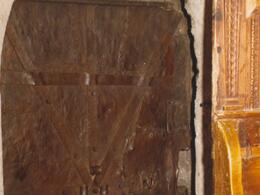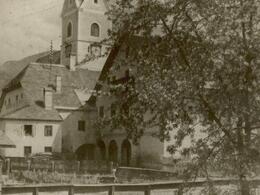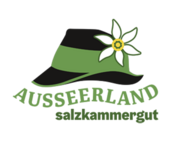Hinterberger Panorama Trail - Simonywarte




- Suitable for kids (all ages)
Parish and parish church
Until the 14th century Mitterndorf belonged to the parish of Pürgg. In the course of the re-division of ecclesiastical organisational areas due to the growth of settlement and population, a parish of its own was also created in Hinterbergertal in 1335. The area between Knoppen and the Kulmbach was defined as the parish. The patron saint of the Mitterndorf parish church is worth mentioning: Saint Margaret, a dragon saint. The nobility of the time loved chivalrous saints as church patrons, such as St. George as the dragon slayer (the dragon was a symbol of evil in the Middle Ages), after whom, for example, St. George's Church in Pürgg is named. There are also assumptions about the interpretation of the female saint figures in the Mitterndorf church as having Celtic roots. Last but not least, it is assumed that the church of St. Margaretha was also built on a pre-Christian cult site. A predecessor church is assumed; remains from Romanesque times were discovered during construction work. The late Gothic church building that still exists today dates from the 14th and 15th centuries. A special feature of the Mitterndorf parish church, as well as other churches in the area, is the late Baroque decoration by the sculptor Johann Fortschegger, who lived in Mitterndorf at the end of the 18th century.
The Protestant Church in Mitterndorf
With the Tolerance Patent of Josef II. (1781) ended the persecution of Protestants in Austria. But it was not until the end of the 19th century that official Protestant congregations were formed again in the Styrian Salzkammergut for the first time since the Reformation. In 1899, a Protestant service was held in Aussee for the first time in 300 years, and members of the newly founded Protestant congregation also came from Mitterndorf. As their numbers increased, the then Protestant pastor Ernst Gottfried Mayer decided to build his own church in Hinterbergertal in the early 1930s. According to a plan by the architect and master builder Hans Jelem, a Protestant wooden church in the Nordic style was built in 1934 with the name "Kreuz-kirche".
The end of the old saltworks economy and a new age
The construction of the railway line through the Salzkammergut (1877) had immediate consequences for the region. With the help of the railway, coal replaced wood as a fuel. It meant the end for the regional timber industry in its traditional form as well as for the centuries-old cartage system. However, the railway opened up new perspectives: on the one hand, it made it possible to export timber, and on the other, it promoted the development of tourism in the region. Before 1914, Mittern-dorf was primarily a timber trade landscape with the first traces of tourism. Forests, sawmills and handicraft enterprises and farming as a sideline. The valley was also increasingly "discovered" as a summer resort. In 1888 the doctor Heinrich Lobenstock opened a bathing establishment. In the 1890s a bathhouse was built at the Heilbrunn spring. In 1896, Mitterndorf tradesmen founded a beautification association. In 1899 a brewery of the Hinterberger Brewery started its operations. A refuge was built at the Steirersee in 1900 and the first ski runs took place in 1905. New middle-class buildings and many a villa enrich the face of the village, which was characterised by its rural and artisanal character.
Mountains, snow and water - the path to a tourist landscape
Mitterndorf's burgher families began to take the first initiatives for the summer resort. The teacher and writer Hans Fraungruber, who was a friend of Peter Rosegger, also contributed to the town's fame. The turn of the 20th century was marked by a spirit of optimism in Mitterndorf, which, however, came to a standstill due to the two world wars. From the 1960s onwards, the face of Mitterndorf, Tauplitz and the Tauplitzalm was transformed by enormous infrastructural development and building activity based on growing prosperity and increasing tourist demand. Important projects of these years included the construction of the Tauplitzalm Alpine Road, the establishment of the Heilbrunn spa and the building of holiday settlements such as the "Son-nenalm". Within a few years, an investment and building boom transformed Mitterndorf into one of Styria's successful tourist communities. At the beginning of the 1970s, the awarding of the title "Kurort" (health resort) and the title "Bad" (spa) crowned this development.
The pioneering days of winter sports
The beginnings of Austrian winter sports date back to the 1890s. With k.u.k. Officers like Matthias Zdarsky, skiing did not begin in the Tyrolean mountains, but in Lilienfeld in Lower Austria and in Mürzzuschlag in Styria. During the time of the monarchy, Mitterndorf was one of the pioneer communities of the new white sport. The innkeeper Emmerich Oberascher and others from Mitterndorf established the new sport in their home. The legendary first ascent of the Lawinenstein by Ferdinand Sulzbacher and Hiob Engl in the winter of 1905/06 marked the beginning of winter sports. As the need for accommodation and supplies increased, the first ski hut was set up on the Rossalm in 1907. The need to look after guests in emergencies led to the establishment of an "Alpine Rescue Centre" as the forerunner of the later mountain rescue service. In the years before the outbreak of the First World War, the Hinterbergertal and the Tauplitzalm became an important centre for winter sports in the Eastern Alps. The railway connection enabled skiing enthusiasts to travel from Graz, Vienna and Munich. In the inter-war period, the enthusiasm for winter sports also continued through the special achievements of Mitterndorfers: Robert Kanzler, a winter sportsman born in Krungl, advanced as a master tailor to become the inventor of the legendary wedge trousers. Leo Gasperl was one of the most successful ski racers of his time and made a career in Italy.
Grubegg
In 1572 Andrä Gruber, an influential Aussee citizen and merchant, acquired several properties in the Hinterberger valley. In 1591, in his efforts to build a seat of power, he extended a farm on a hill into a castle. When Gruber died in 1600, his son took over the newly built castle and received a so-called "charter" for himself and his sister Salome in 1606. The castle, a mill as well as other plots of land and farms were all taken out of the Hinterberg dominion and added to the new dominion. The family received permission to call the seat "Grubegg". This is how the "Lordship of Grubegg", which had been separated from the Lordship of Hinterberg, came into being. This subsequently changed hands several times until it was finally taken over by the Hallamt of Aussee in 1758. At the end of the 18th century, a hammer mill was built in the south of the estate, and the castle became the administrative seat of the salaried officials responsible for the mill. From 1850 the castle was the seat of the k.k. Forst- und Domänenverwaltung Hinterberg, the later Bundesforste.
Pass Stein
In the course of the economic boom in the late Middle Ages, a faster connection from the Enns Valley to the Salzkammergut was obvious. It is therefore assumed that it was not until this time that a road was built through the Stein Pass in the direction of the Enns Valley and the Sölk Pass. There is no evidence of this from the time before. In 1824 the Duchy of Styria elevated the road to the status of a district road on the initiative of the Steiermärkische Landwirtschaftsgesellschaft (Styrian Agricultural Society). In 1840 Pass Stein was upgraded to a road. In the 19th century, middle-class and aristocratic travel writers and "Alpine hikers" discovered the tourist appeal of the path through the Stein, which led to historical descriptions of the pass. Today, the Stein Pass is closed.
Heilbrunn
The healing spring of Heilbrunn, situated at the foot of the Grimming on the southern edge of the valley, has already been proven in Roman times. It was also used in the Middle Ages to treat ailments. The more recent history of Heilbrunn began at the end of the 18th century. Hammer mill workers used the nearby spring. The salt works administration had a hut built in 1830. The "Bad Heilbrunn von Grubegg" attracted nationwide interest. In the course of the rise of the Aussee summer resort around 1900, the imperial and royal forestry administration, but above all the sawmill, made efforts to develop the area. In the course of the growing summer resort in Aussee around 1900, the imperial and royal forestry administration, and above all the sawmill owner Johann Loitzl, endeavoured to further develop and commercially exploit the springs. In 1906, the spring was officially recognised as a medicinal spring. However, commercial success failed to materialise. The modern Bad Heilbrunn got its face in the early 1960s when the Heilbrunn spa opened its doors. It was the deciding factor for the awarding of the title "Bad" to the municipality. If Bad Heilbrunn is a spa today, a second location for the use of the healing waters was created in 2009 with the new Grim-mingtherme.
- Hiking
The Hinterberg Panorama Trail can be hiked free of charge.
- Suitable for kids (all ages)
- Suitable for children
Please get in touch for more information.
Contact
8983 Bad Mitterndorf
Phone +43 3623 22 - 02
E-Mail gde@bad-mitterndorf.steiermark.at
Web gemeinde.bad-mitterndorf.at/de/
Contact person
Marktgemeinde Bad Mitterndorf
Bad Mitterndorf 59
8983 Bad Mitterndorf
Phone +43 3623 22 - 02
E-Mail gde@bad-mitterndorf.steiermark.at
Web gemeinde.bad-mitterndorf.at/de/



























